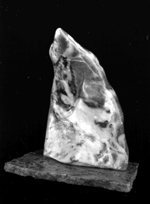Many years ago I wrote an article about firing soapstone to make the stone harder. It is possible to harden the stone to the point that you cannot scratch it with anything short of steel. This will also close the structure of the stone enough to allow it to be used in outdoor applications. I have had several people approach me about this technique so I thought that I would reprise it with some of the things I have learned since then.
I have been working soapstone for the last 12 years and have talked to many of you about your experiences and here are some of the things I have found out. First, soapstone is soft. Now, that may seem obvious but there is more to it than that. Soapstone is chemically close to clay and as such, can be handled in a similar way. It can be “fired” to artificially do what takes nature much longer. I have found out from Ron Gietgey that this technique of heating soapstone is not new or strange. Insulators on the electric poles were at one time made of fired soapstone.
This is not a technique to be used with any other type of stone, especially alabaster. I have not taken the opportunity to try this on other types of stone in the same family, such as talc, pipestone or chlorite. Many of these stone will get harder over time or as they are worked so I didn’t feel this extra step necessary.
Some problems with this method occur because soapstone can have organic intrusions that will burn out during firing affecting the outcome of the piece. Be careful picking the stone that you are considering firing. Be aware that these intrusions may not be noticeable prior to firing. If you are feeling very attached to a piece, it may be better to simply accept the limitations of the stone. So, keep intrusions in mind when choosing and working soapstone you are planning to fire. In the worst of cases they can leave voids that may have devastating results, even causing the pieces to fall apart. In addition, soapstone, which is available in a wide variety of colors, may alter in color when exposed to high temperatures.
My first test of this technique was in a kiln. I created a number of small pieces of soapstone sculpture. They were then fired at different temperatures. Fortunately these pieces for the most part had very little intrusions of organic material. They became very hard and the color changed to a rich brown. The patterning remained but was much more subtle. However, later pieces I worked had intrusions that did leave voids. In some cases I left these voids as they worked with the “look” I wanted. In other cases I filled the voids with clear or tinted epoxy. The different temperatures impacted the pieces in appearance and form. The higher the temperature, the harder and darker the stone becomes.
Getting the desired results may not require a high temperature firing. You can get reasonable results using your home oven, raising the temperature slowly over an extended period. However, if there are organic intrusions these will burn out even at the lower temperature.
Now for the specifics of how this is done. I found that it is best to finish the piece to the final sanding. Sign the piece at this point. Then you simply place the piece in a kiln and fire to cone 01 using a slow, stepped temperature increase that will probably take as much as 24 hours to achieve. Afterwards the cooling should take another 8 hours. When this has been done, the piece can be treated as you would any other stone with a sealant and wax. Patience is the most important ingredient. Although I have taken pieces up to cone 4, I do not think that it is necessary to achieve the desired results.
If you are going to use your home oven, put the piece into a cold oven on the middle rack and start at the lowest temperature available, slowly increasing the temperature as the stone, not the oven, reaches that temperature. This may take up to an hour or more with each step depending on the size of the stone. Repeat this as you raise the temperature in 100-degree steps, to a high of no more than 500 degrees. Cool the stone with the door closed for several hours, until the stone is cool to the touch. The center of the stone will probably still be hot so leave it alone for a day or so.
I was interested in investigating this because I wanted to make small pieces that could be handled and used as worry stones. I have had very good results with this technique. To use this on larger work it is important to go slowly. The larger the piece the more problematic it will be to heat it up evenly.

